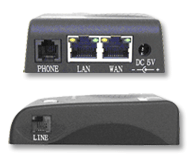HandyTone-488

Ports
- 1 Power (5V)
- 1 RJ45 WAN
- 1 RJ45 LAN
- 1 RJ11 FXS
- 1 RJ11 FXO/PSTN
This is (mostly) a step up from the Grandstream Handytone-486
While unpowered, the PSTN RJ11 is directly connected to the FXS RJ11.
When powered, the analog phone is is disconnected from the PSTN line. Dialing “*00” (configurable) causes a relay to join the analog phone to the PSTN to force outgoing calls via PSTN. Plus, up to 5 dial patterns (“911”) can be programmed which go out via PSTN. Otherwise dialing is done via the FXS VOIP.
When a call arrives via the FSX (VOIP) port or the PSTN port, the attached analog phone rings.
Bugs:
- The “early dial” feature does not work. E.g. if you want it to pass each dialed key to the PBX as it is pressed rather than taking your whole number (followed by the ‘#” key or a 4-second timeout) before sending to the PBX, it doesn’t work. Well known Grandstream bug in many of their products. With Asterisk, pressing the 2nd digit with early dial enabled, causes an instant dial failure.
Issues:
- The HT-488, unbelievably, does not pass CallerID from the incoming PSTN call through to the PBX. It does pass the CallerID over to the FSX line and is visible on a CallerID-aware analog phone.
- Unlike the HT-488, the “LAN” port is only NAT’d behind the WAN port. On the HT-486, one can choose to have the LAN port switched(bridged) to the WAN port or NAT’d.
- For outgoing calls from PBX through the FXO port, the actual number dialed in the SIP INVITE is ignored. Instead the HT-488 “answers” the call itself and waits for an optional PIN followed by the destination PSTN phone number before actually taking the PSTN line off-hook and actually dial. Not a big deal for Asterisk. Use a the “D” flag to the Dial application. Don’t forget to use a leading ‘w’ on the number to wait a bit before dialing.
- The HT-488 does not support Disconnect Supervision. It only supports silence detection and disconnect tone detection. Grandstream is working on this: “We are working actively now to get the PSTN disconnect issues solved. We do detect polority reversal in our current firmware, but it is not working properly with the released firmware.”
- Incoming PSTN calls must ring the FXS port at least once before being forwarded to VoIP.
Nice features:
- Unlike the HT-486, the analog phone connected to the FXS port can access the PSTN line with more than just the “*00” pattern. It allows for things like “911”. In my mind this one feature makes the HT-488 useful for applications where you would have used the HT-486. Just ignore the FXO port of the HT-488.
- The Voicemail Waiting Indicator works fine. The button on the top of the unit blinks green slowly.
- Unlike the Digium T4xxP cards, the HT-486 returns a SIP BUSY status if there is no phone line connected to the FXO port, or if there is a call in progress already.
A configuration guide for Asterisk and HT-488
Go back to VoIP Gateways

